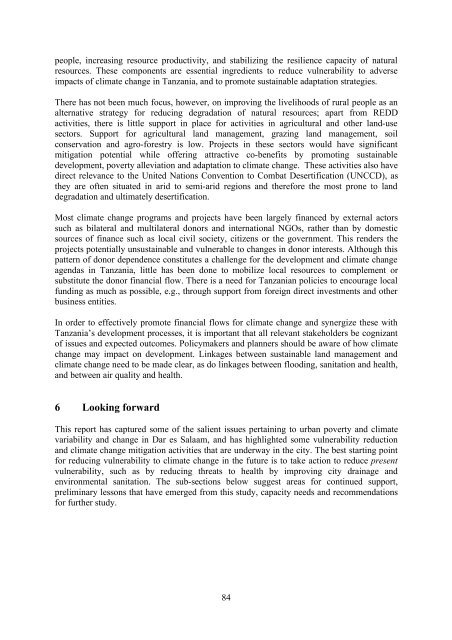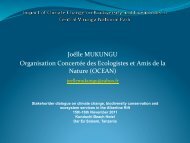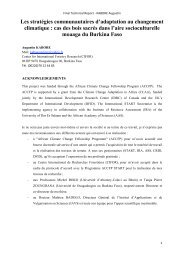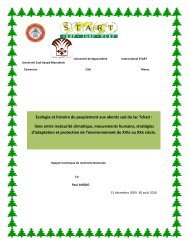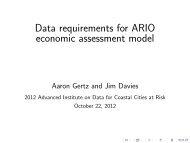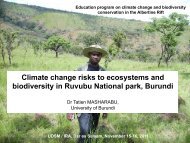Urban Poverty & Climate Change in Dar es Salaam, Tanzania:
Urban Poverty & Climate Change in Dar es Salaam, Tanzania:
Urban Poverty & Climate Change in Dar es Salaam, Tanzania:
You also want an ePaper? Increase the reach of your titles
YUMPU automatically turns print PDFs into web optimized ePapers that Google loves.
people, <strong>in</strong>creas<strong>in</strong>g r<strong>es</strong>ource productivity, and stabiliz<strong>in</strong>g the r<strong>es</strong>ilience capacity of natural<br />
r<strong>es</strong>ourc<strong>es</strong>. Th<strong>es</strong>e components are <strong>es</strong>sential <strong>in</strong>gredients to reduce vulnerability to adverse<br />
impacts of climate change <strong>in</strong> <strong>Tanzania</strong>, and to promote susta<strong>in</strong>able adaptation strategi<strong>es</strong>.<br />
There has not been much focus, however, on improv<strong>in</strong>g the livelihoods of rural people as an<br />
alternative strategy for reduc<strong>in</strong>g degradation of natural r<strong>es</strong>ourc<strong>es</strong>; apart from REDD<br />
activiti<strong>es</strong>, there is little support <strong>in</strong> place for activiti<strong>es</strong> <strong>in</strong> agricultural and other land-use<br />
sectors. Support for agricultural land management, graz<strong>in</strong>g land management, soil<br />
conservation and agro-for<strong>es</strong>try is low. Projects <strong>in</strong> th<strong>es</strong>e sectors would have significant<br />
mitigation potential while offer<strong>in</strong>g attractive co-benefits by promot<strong>in</strong>g susta<strong>in</strong>able<br />
development, poverty alleviation and adaptation to climate change. Th<strong>es</strong>e activiti<strong>es</strong> also have<br />
direct relevance to the United Nations Convention to Combat D<strong>es</strong>ertification (UNCCD), as<br />
they are often situated <strong>in</strong> arid to semi-arid regions and therefore the most prone to land<br />
degradation and ultimately d<strong>es</strong>ertification.<br />
Most climate change programs and projects have been largely f<strong>in</strong>anced by external actors<br />
such as bilateral and multilateral donors and <strong>in</strong>ternational NGOs, rather than by dom<strong>es</strong>tic<br />
sourc<strong>es</strong> of f<strong>in</strong>ance such as local civil society, citizens or the government. This renders the<br />
projects potentially unsusta<strong>in</strong>able and vulnerable to chang<strong>es</strong> <strong>in</strong> donor <strong>in</strong>ter<strong>es</strong>ts. Although this<br />
pattern of donor dependence constitut<strong>es</strong> a challenge for the development and climate change<br />
agendas <strong>in</strong> <strong>Tanzania</strong>, little has been done to mobilize local r<strong>es</strong>ourc<strong>es</strong> to complement or<br />
substitute the donor f<strong>in</strong>ancial flow. There is a need for <strong>Tanzania</strong>n polici<strong>es</strong> to encourage local<br />
fund<strong>in</strong>g as much as possible, e.g., through support from foreign direct <strong>in</strong>v<strong>es</strong>tments and other<br />
bus<strong>in</strong><strong>es</strong>s entiti<strong>es</strong>.<br />
In order to effectively promote f<strong>in</strong>ancial flows for climate change and synergize th<strong>es</strong>e with<br />
<strong>Tanzania</strong>’s development proc<strong>es</strong>s<strong>es</strong>, it is important that all relevant stakeholders be cognizant<br />
of issu<strong>es</strong> and expected outcom<strong>es</strong>. Policymakers and planners should be aware of how climate<br />
change may impact on development. L<strong>in</strong>kag<strong>es</strong> between susta<strong>in</strong>able land management and<br />
climate change need to be made clear, as do l<strong>in</strong>kag<strong>es</strong> between flood<strong>in</strong>g, sanitation and health,<br />
and between air quality and health.<br />
6 Look<strong>in</strong>g forward<br />
This report has captured some of the salient issu<strong>es</strong> perta<strong>in</strong><strong>in</strong>g to urban poverty and climate<br />
variability and change <strong>in</strong> <strong>Dar</strong> <strong>es</strong> <strong>Salaam</strong>, and has highlighted some vulnerability reduction<br />
and climate change mitigation activiti<strong>es</strong> that are underway <strong>in</strong> the city. The b<strong>es</strong>t start<strong>in</strong>g po<strong>in</strong>t<br />
for reduc<strong>in</strong>g vulnerability to climate change <strong>in</strong> the future is to take action to reduce pr<strong>es</strong>ent<br />
vulnerability, such as by reduc<strong>in</strong>g threats to health by improv<strong>in</strong>g city dra<strong>in</strong>age and<br />
environmental sanitation. The sub-sections below sugg<strong>es</strong>t areas for cont<strong>in</strong>ued support,<br />
prelim<strong>in</strong>ary l<strong>es</strong>sons that have emerged from this study, capacity needs and recommendations<br />
for further study.<br />
84


